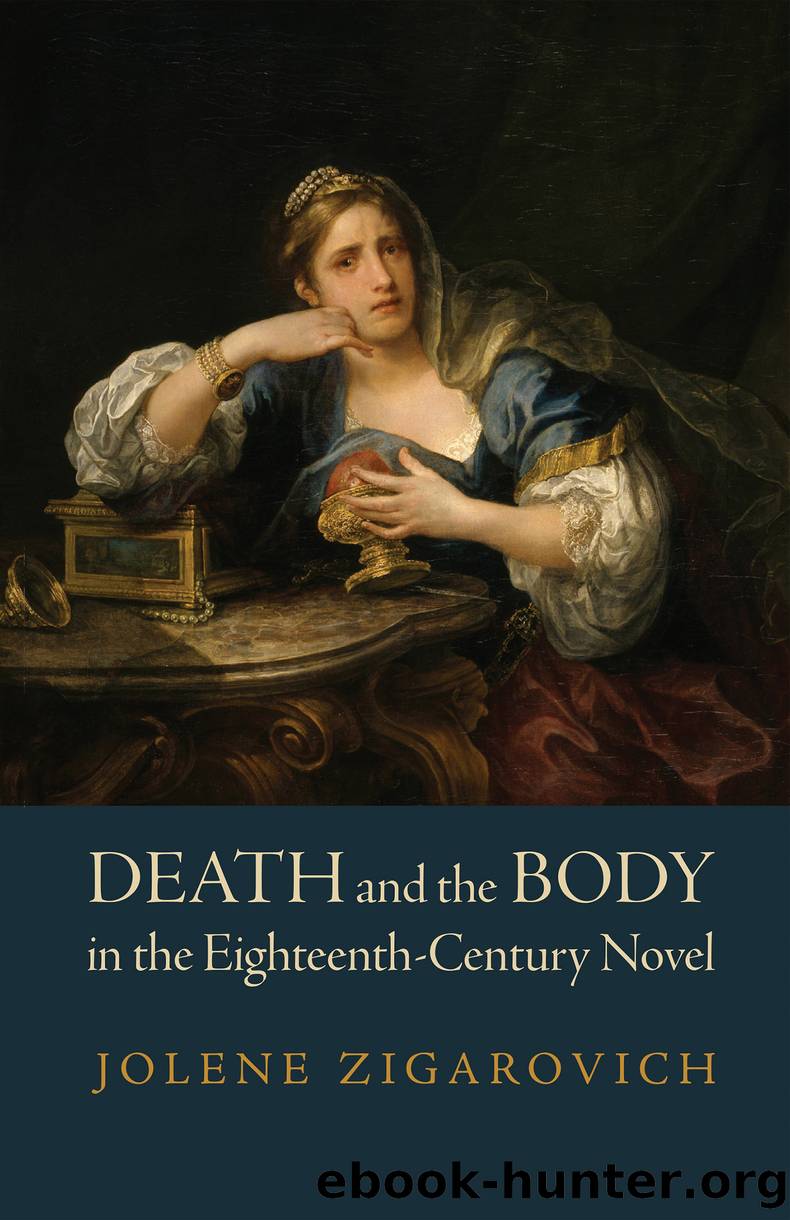Death and the Body in the Eighteenth-Century Novel by Jolene Zigarovich

Author:Jolene Zigarovich
Language: eng
Format: epub
Publisher: University of Pennsylvania Press, Inc.
Though Fennetaux remarks that placing hair in mourning rings decreased in popularity, we still witness the practice in the early nineteenth century. For example, in 1818, James T. Power, fearing he would die on a trip to Sierra Leone, wrote to his love Julia Woodforde describing his plans for a mourning ring to be made for her, entwining each of their locks of hair: âI purchased yesterday a Diamond Mourning ring, I will place a brade [sic] of your hair and mine in it. ON the inside I will inscribe James T Power died ⦠leaving a vacancy for the date if this should be my fate shortly you will receive an account of the time and get it filled up and I have no doubt you will regard the ring with affection and wear it on my account.â45 These examples and others also indicate that sentimental practices that developed around mourning jewelry were not gender specific. Interlocked hair from two lovers generates notions of bodily connection, and intersects both love and grief. Lockets, rings, miniatures, and other material artifacts housing hair encapsulate the growing emotional economy centered on the body, loss, and mourning.
We have seen that jewelry acts as both love token and mourning memento, especially cherished if created with hairwork. In Elizabeth Justiceâs Amelia, or, The Distressâd wife: a history founded on real circumstances. By a private gentlewoman (1751), published on the heels of Clarissa, Justice describes the deathbed preparations of Ameliaâs mistress Mrs. Sweet, who has contracted smallpox. Her preparations include hair jewelry: âTwo or three days before she died, she said to Amelia, My dear, you will oblige me to go to Mr. Bluntâs, the Goldsmith, and desire him to make a Mourning Ring with a Christal, in a Lozinge; for I should love to see the Rings that I design for my friends.â46 Though not described, the lock of hair, we can assume, would be encased. In Helen Craikâs anti-Jacobin Adelaide de Narbonne, with memoirs of Charlotte de Cordet (1800), Victorine opens a casket containing her dead parentsâ valuables, including their miniatures, but it is their hair jewelry that is most prized and intimate: she discovers âlockets containing the united ciphers of her parents, done in their own hair.â47 Along with rings and brooches, lockets would be common relics for the middle and upper classes. This mourning locket is a beautiful example of mourning hairwork such as Craik describes, including the blond hair of the âCountess Dowager of Home died 15 Jany 1784â (inscribed on the back) with her initials âECJâ under a coronet of gold and pearls under glass (fig. 4.2). In Elizabeth Griffithâs epistolary novel The Delicate Distress (1769), Lady Woodville describes a miniature portrait worn as a bracelet: âCharming lady Lawson! What an engaging countenance, what a quick sensibility in her looks, what an irresistible smile! I am not under a necessity of looking at my bracelet, to remind me that this portrait resembles lady Straffon: but lady Lawson is taller, thinner, and more of the brunetteâ (12).
Download
This site does not store any files on its server. We only index and link to content provided by other sites. Please contact the content providers to delete copyright contents if any and email us, we'll remove relevant links or contents immediately.
| Anthropology | Archaeology |
| Philosophy | Politics & Government |
| Social Sciences | Sociology |
| Women's Studies |
The Leavers by Lisa Ko(6471)
Born to Run: by Christopher McDougall(6259)
iGen by Jean M. Twenge(4702)
Sapiens by Yuval Noah Harari(4534)
The Kite Runner by Khaled Hosseini(4430)
Spare by Prince Harry The Duke of Sussex(4195)
Bullshit Jobs by David Graeber(3179)
Livewired by David Eagleman(3121)
Goodbye Paradise(2958)
Never by Ken Follett(2878)
A Dictionary of Sociology by Unknown(2517)
Harry Potter 4 - Harry Potter and The Goblet of Fire by J.K.Rowling(2416)
The Club by A.L. Brooks(2357)
People of the Earth: An Introduction to World Prehistory by Dr. Brian Fagan & Nadia Durrani(2346)
The Social Psychology of Inequality by Unknown(2309)
Machine Learning at Scale with H2O by Gregory Keys | David Whiting(2285)
Harry Potter and the Order of the Phoenix (5) by J.K. Rowling(2226)
0041152001443424520 .pdf by Unknown(2219)
Don't Sleep, There Are Snakes by Daniel L. Everett(2216)
